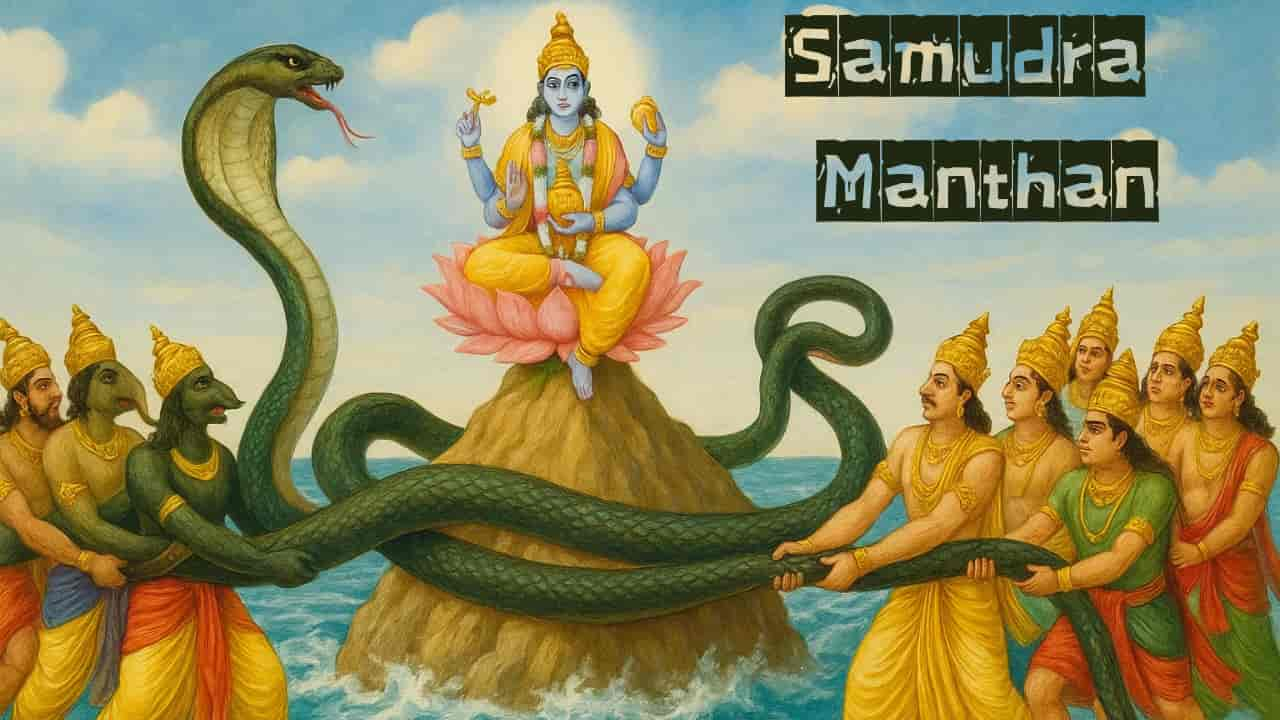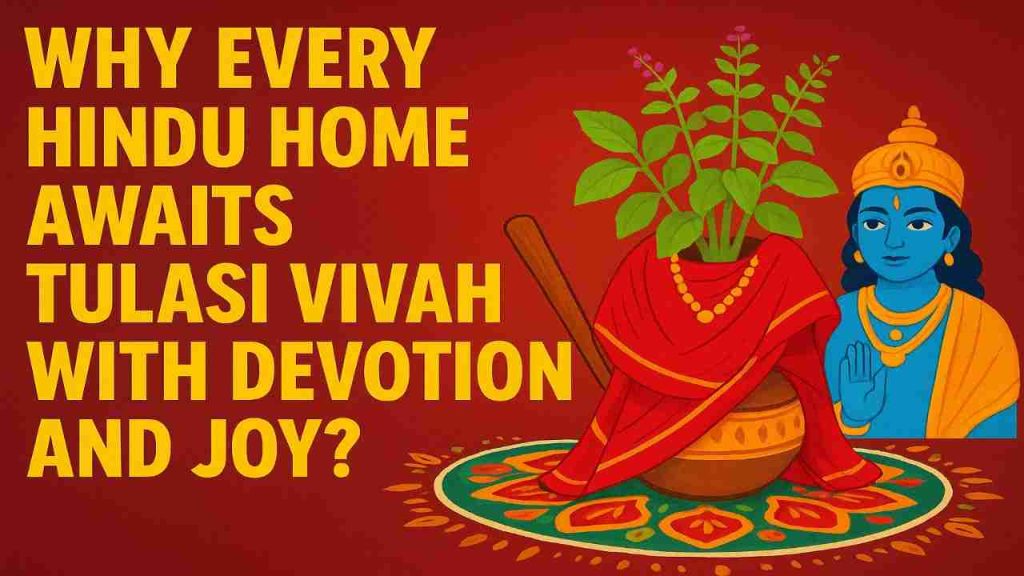
A Cosmic Crisis Unfolds
In Hindu mythology, the story of Samudra Manthan, the churning of the ocean, is one of the most profound and symbolic tales. It’s not just a myth about gods and demons; it’s a metaphor for life, balance, and the pursuit of immortality.
The tale begins with a crisis. The gods had lost their strength due to a curse by the sage Durvasa. Without their divine powers, they were vulnerable to the demons (asuras), who began to dominate the universe.
Samudra Manthan: The Quest for Amrit
To regain their strength, the gods needed amrit, the nectar of immortality. But the nectar was hidden deep within the cosmic ocean. Retrieving it was no ordinary task.
The gods realized they couldn’t churn the ocean alone. They needed help. Surprisingly, they turned to their enemies, the demons, for assistance. Lord Vishnu proposed a temporary alliance, convincing both sides to work together and share the nectar.
The Cosmic Churning Begins
To churn the ocean, the gods and demons used:
- Mount Mandara as the churning rod
- Vasuki, the king of serpents, as the rope
- Lord Vishnu, in his Kurma (tortoise) avatar, to support the mountain from below
As the Samudra Manthan began, the mountain started sinking. Vishnu took the form of a giant turtle and balanced the mountain on his back, allowing the process to continue.
Emergence of Divine Treasures
The Samudra Manthan was intense and cosmic. As the ocean swirled, several divine treasures emerged. Each had its own significance and was claimed by the gods.
Some of the key items that surfaced included:
- Kamadhenu – the divine cow that grants wishes
- Airavata – the white elephant later ridden by Indra
- Kalpavriksha – the wish-fulfilling tree
- Chandra – the moon god
- Lakshmi – the goddess of wealth and prosperity
- Dhanvantari – the divine physician holding the pot of nectar
These treasures symbolized the rewards of spiritual effort and cosmic balance.
The Threat of Halahala
Not everything that emerged was divine. A deadly poison called Halahala surfaced from the ocean, threatening to destroy all life. Neither the gods nor the demons could contain it.
In desperation, they turned to Lord Shiva. Without hesitation, Shiva drank the poison to save the universe. His throat turned blue, earning him the name Neelkanth, the blue-throated one.
Mohini's Divine Strategy
After the poison was neutralized, the churning continued. Finally, Dhanvantari appeared with the pot of nectar. The demons immediately seized it and fled, refusing to share it with the gods.
To retrieve the nectar, Lord Vishnu transformed into Mohini, a beautiful enchantress. Her charm was irresistible. The demons, mesmerized by her beauty, agreed to let her distribute the nectar. Mohini cleverly gave it only to the gods, restoring their strength and immortality.
Rahu and Ketu's Celestial Role
One demon, Rahu, disguised himself as a god and drank the nectar. But before it could pass through his throat, Mohini exposed him. Lord Vishnu beheaded Rahu instantly.
Since the nectar had touched his mouth, Rahu’s head became immortal. His body, known as Ketu, also gained celestial status. It is said that Rahu and Ketu still chase the sun and moon, causing eclipses.
Symbolism in Samudra Manthan
The story of Samudra Manthan is rich in symbolism and spiritual meaning. It represents the inner struggle between good and evil, and the process of self-discovery.
Key symbolic elements include:
- The Ocean – the mind or consciousness
- Churning – the effort to extract truth and wisdom
- Poison – ego, ignorance, and negativity
- Nectar – enlightenment, immortality, and divine knowledge
- Mohini – illusion and divine strategy
The cooperation between gods and demons teaches that even opposing forces can work together for a greater purpose.
Philosophical Lessons from the Myth
Samudra Manthan offers timeless lessons that apply to both spiritual seekers and everyday life.
- Balance is essential: Good and evil, effort and rest, must coexist for progress
- Sacrifice is noble: Shiva’s act of drinking poison shows the power of selflessness
- Wisdom wins: Vishnu’s transformation into Mohini highlights the importance of intelligence and strategy
- Desire must be controlled: The demons’ greed led to their loss, while the gods’ patience earned them victory
- These lessons are not just mythological: they are deeply philosophical and practical.
Cultural Celebrations and Influence
The story of Samudra Manthan appears in several Hindu scriptures, including the Bhagavata Purana, Vishnu Purana, and Mahabharata. It is also depicted in temple art, festivals, and rituals across India and Southeast Asia.
One of the most famous celebrations inspired by this myth is the Kumbh Mela. According to legend, drops of nectar fell at four places, Haridwar, Prayagraj, Nashik, and Ujjain, during the chase between gods and demons. These cities now host the Kumbh Mela, where millions gather to bathe in sacred rivers.
Artistic Depictions in Temples
Samudra Manthan is a popular theme in temple carvings and sculptures. The most famous depiction is at Angkor Wat in Cambodia, where a massive bas-relief shows gods and demons pulling the serpent Vasuki.
In Indian temples, especially those dedicated to Vishnu and Shiva, scenes from the churning are carved into pillars and walls. These artworks serve as visual reminders of the cosmic struggle and divine intervention.
Spiritual Interpretation in Daily Life
The story also resonates with personal spiritual journeys. The ocean represents our inner world, filled with thoughts, emotions, and desires. Churning it through meditation, discipline, and reflection helps us uncover wisdom and clarity.
The poison we face may not be literal, but it exists in the form of stress, ego, and conflict. The nectar is peace, clarity, and purpose. Churning our inner ocean, through meditation, reflection, and action, can help us reach it.
Modern Relevance and Reflection
Even today, the story of Samudra Manthan remains relevant. It teaches us that life is a mix of challenges and rewards, and that perseverance, cooperation, and wisdom are key to overcoming obstacles.
In a world filled with distractions and divisions, the myth reminds us of the importance of unity, strategy, and sacrifice. It encourages us to look within, churn our thoughts, and seek the nectar of truth.
Samudra Manthan: A Tale of Transformation
Samudra Manthan is more than a myth; it’s a metaphor for the human journey. It shows that even in chaos, there is potential for creation. Even in conflict, there is room for cooperation.
The gods and demons, the poison and nectar, the turtle and the serpent, all represent aspects of ourselves. By understanding this story, we understand the importance of balance, sacrifice, and wisdom in our own lives.
In the end, the churning of the ocean is the churning of the soul. And the nectar we seek is not just immortality, but truth, peace, and enlightenment. It reminds us that life’s greatest rewards often emerge from struggle, and that clarity, strength, and purpose are born from inner effort.
The myth continues to inspire, guiding us to churn our own depths and rise above illusion, conflict, and fear.

